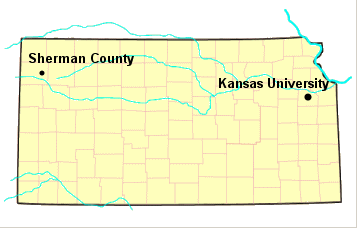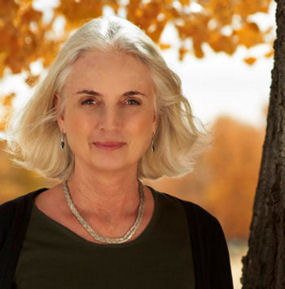| |
When did you decide that you wanted to become a writer? Was it hard for you to realize that dream?
I wrote poems for my high school English teachers and received a little encouragement, but mainly language itself encouraged me. Although I’m sure my poems were sing-songy, I was captured by the ring of a line, by how when you thought you’d found the right words, they kept repeating themselves over and over in your mind, the way images from actual creation do. A line of poetry could seem as complete and perfect as a tulip.
I became serious about writing in my mid-thirties, after I’d made a drastic mistake in my life and got myself stuck back on my parents’ Kansas farm. Before that time, my writing tended toward preachiness. But, chastened by that return home, I had more interest in discovering truth than in pontificating. I went back to school with this dream of becoming a writer. At first, I thought I would write about my adventures in San Francisco and the desert. Those places seemed more exotic and interesting to me, but my fingers kept typing out stories about Kansas, where, as I say in my latest book, The Ogallala Road, “things were not and would never be resolved.”
In what ways is The Ogallala Road different from One Degree West? Both books are set in western Kansas, correct?
One Degree West was a collection of essays written over a period of about ten years. By arranging them and cutting here and adding there, I did manage to make the essays seem part of a whole. But in The Ogallala Road , I set out to tell a story from start to finish.
At first, I intended this book to be solely about the Ogallala Aquifer, the huge groundwater reserves underlying the High Plains. My family irrigated out of the Ogallala and I felt guilty about our small part in its depletion. But the book wound up being about that and much more. It’s about my attempt to reconcile with the place I’m from. I did some foolish things trying to achieve that reintegration, so it’s about those things, and also about trying to raise my son alone when I came from such a patriarchal culture and had such a strong, successful father. Ultimately, it’s about my own family’s struggle to hang onto our land, as my father decreed we should, even though we’re not farmers by inclination. It’s about our grief when we fail at that.
In this book, I don’t just portray my place and my people from my heart’s point of view as I did in One Degree West, but I more thoroughly interrogate the culture. I am going for a more complete and examined look, at the past on the land, for instance, and at the specifics of what’s being done to it now.
This book has the “narrative arc” that New York editors and agents always emphasized when I tried to sell books there in the past. I was annoyed by that supposed necessity to write narratively, when much of experience is interior and less linear, but over the course of writing The Ogallala Road , I began to honor that more and more, making choices according to the story’s pulse. You can’t really engage hearts without a story, and you can’t open minds without first opening hearts. I think it was D. H. Lawrence who said that the purpose of the novel is to expand sympathy. Many writers have said things like that.
Is that what you try to do in your writing – expand sympathy?
Yes, although I write about my own experience in my nonfiction and sometimes feel self-conscious about that. To write successfully as a memoirist or personal essayist, you do have to make yourself sympathetic. The way to do that, ironically, is not to gloss over your failures, but to reveal them. If you’re careful to tell the truth and if you’re sufficiently self-revealing, you will connect with readers. They will see their own lives in new light. Also, it’s really hard to conceal character flaws when you write as personally as I do, and when I find myself trying to do that, I have to strip away yet another layer of reader- and self-deceit. Sometimes the writing itself forces me to reform a little. Instead of leading to more self-absorption, it makes me a little less that way. I gain understanding of others whose lives touched my own. But I write primarily about my connection to the land itself and try to expand people’s sympathy for that.
I also included in this book quite a bit of Native American history, things that weren’t taught in the schools I attended, or maybe I just wasn’t tuned in. Learning that the Dog Soldiers, the most famous Cheyenne warrior society, favored a campground on the Smoky Hill River about thirty miles south of Goodland, the town where I grew up, expanded my awareness of our land’s and the water’s meaning. Ogallala Aquifer springs feed all those little creeks and rivers of western Kansas. Even the paltry Little Beaver, which was just a dry creek on the farm where I grew up, had springs in it a few miles east of us. Along with mightier rivers such as the Platte and the Arkansas, it was on what historians call the Ladder of Rivers. Those waterways between north Texas and the Dakotas made the migration of humans and game possible all the way back to the Clovis period, thirteen-thousand years ago. Now, with irrigation, all those springs are drying up.
I do a lot with the aquifer story and the Cheyenne Indian past in this book, but I keep coming back to my own, very personal story, because I believe that’s what readers want. That’s what we all want—intimate knowledge from other lives so we can figure out our own.
When will The Ogallala Road be out?
March 2014. After more years than I care to confess it took me to write it, it is finally being published by Viking/Penguin. They’ve been a fantastic publisher to work with
Can you name some Kansas authors that have influenced you?
I’m ashamed to say that I haven’t read as many Kansas authors as I should have. Gwendolyn Brooks was born in Kansas, but left when she was just a baby. I don’t read poetry often enough, but if it’s to be influenced when words punch you in the stomach, because they are powerful and true, then she influences me. Another Kansas-born poet, Edgar Lee Masters, left when he was only a baby, but his masterful character depictions in Spoon River Anthology encouraged me to think more imaginatively about the inner lives of the people around me. He also validated the drama of small-town or rural life, helping me get over the “I’m from nowhere” syndrome. William Stafford’s poetry never fails to amaze me. It’s exciting to read your own landscape transformed by the literary imagination of a great poet.
My brother, Bruce Bair, is the funny, acerbic author of Good Land. Part of my early writing urge came from thinking him a genius and wanting to be just like him. Wes Jackson writes wisely about being native to a place, and his research into sustainable farming encourages all writers seeking a new land ethic. In researching The Ogallala Road , I became familiar with some Kansas historians, among them William Y. Chalfant and John Monnett, who actually lives and teaches in Denver. Their books on Cheyenne Indian history make it clear how central our central Plains were to the Plains Indian Wars. These writers are very careful yet inspired historians, bringing even-handed insight to bear on the Cheyenne and our conflicts with them. Donald Worster is an inspiration to me whenever I think about the social history of farming in western Kansas. And I think that Thomas Frank totally nailed it in What’s the Matter with Kansas.
What other writers have influenced you?
Alice Munro, because of the honest, deceptively plain-seeming way she delves into her characters’ personal histories. Lives of Girls and Women is one of my favorite books. Many Kansas readers could relate to it, as it tells the story of a small-town girl’s intellectual development—how she grew out of the place almost despite herself, and despite it. N. Scott Momaday’s House Made of Dawn is another of my favorite books, because it portrays the supreme role that home land plays in the lives of its characters. I also like the subjectivity and non-linearity of this book, the way it drops you into the mind of its main character, a Pueblo Indian man returning disoriented from World War II. Usually, my favorite writers are the ones whose books I read and loved most recently: Nick Flynn’s Another Bullshit Night in Suck City, Mark Doty’s Firebird, Debra Marquart’s The Horizontal World. I read them as I put the finishing touches on The Ogallala Road , and each encouraged me to reach higher, try harder.
Do you plan any more books in the future? What kind of stories interest you?
Since I’m just coming out of a long book project, which I thought would last about two years when I first dived into it, it’s hard for me to envision another entire book right now. I’ll probably spend the next year or two writing essays and articles. Some will be spin-off’s from The Ogallala Road —articles about the Ogallala, the current state of organic wheat farming, and the waste entailed in corn-based ethanol. Others will be attempts to go deeper into some of the ideas the book raises but which I couldn’t explore thoroughly within the context of the story I was telling—the notion of personal identity as its influenced by land ownership, and more, I hope, on the Southern Cheyenne. My next book will most likely be an essay collection. After holding my own feet to the fire and complying to the demands of narrative, I look forward to luxuriating again in the essay form.
Return to Top of Page |
|
|
| |
I grew up on the mild-green, short-tufted, buffalo grass prairies of northwestern Kansas. The High Plains they are called, and my family's spot upon them was Highland Farm. We were lifted on that great plain, four-thousand feet above sea level, exposed to the sky, not cradled and protected by the earth the way Iowa or Minnesota farm families are. Each family in rural Kansas was alone together on the flat. At night we had distant yellow lights to remind us that we did have neighbors, but when those blinked off at bedtime, only the moon and stars penetrated the dark. Coyotes howled in our front yard.
When the Thanksgiving season approaches, I think of that home place and our big corner of Kansas more intensely than at other times, though, to tell the truth, it is on my mind always. Our rock-hard farmyard, gnarly with implement tracks and bony bumps, is the ground I walk on still, the given against which the baseline of my city life is too many eons removed. Here in town, the earth suffocates beneath pavement. Reality seems smoothed over, and I feel as if I'm the only one who isn't fooled. Beneath sidewalks and somehow beyond my neighbors' shiny cars and their meticulously raked yards, and then at whatever friend's house my son and I dine this year, a wintry defiance lurks, reminding me that except for that one savory hour when we eat, this holiday is a heart beating out into nothingness.
---Excerpt from One Degree West: Reflections of a Plainsdaughter (from page one of “Disappearances,” the opening essay)
Return to Top of Page |
|
|





